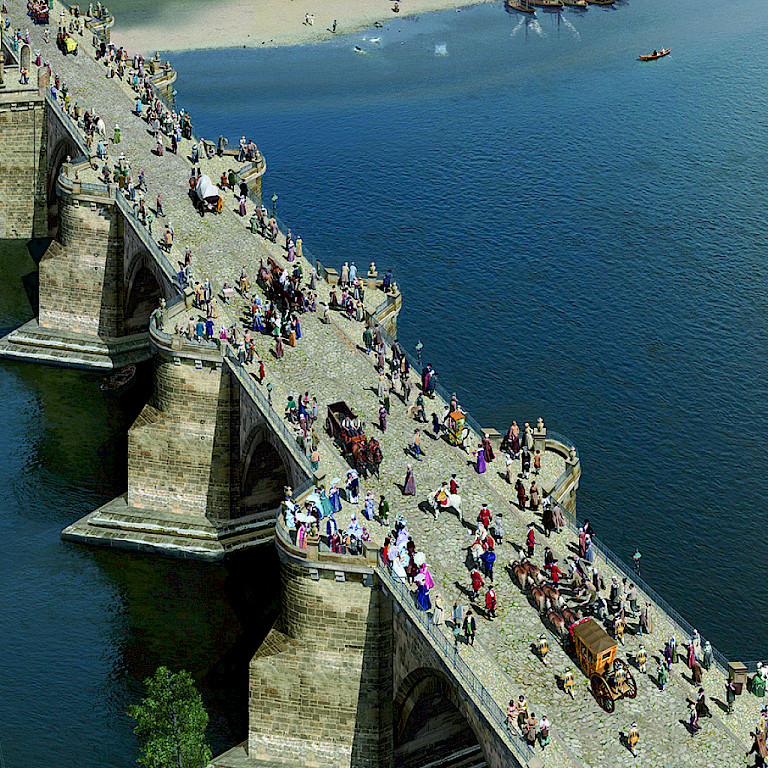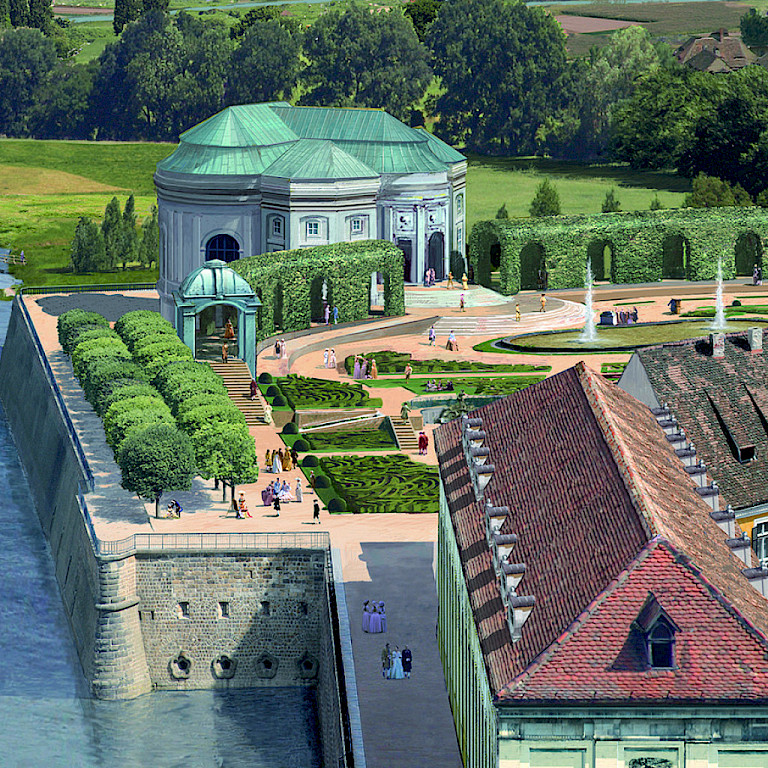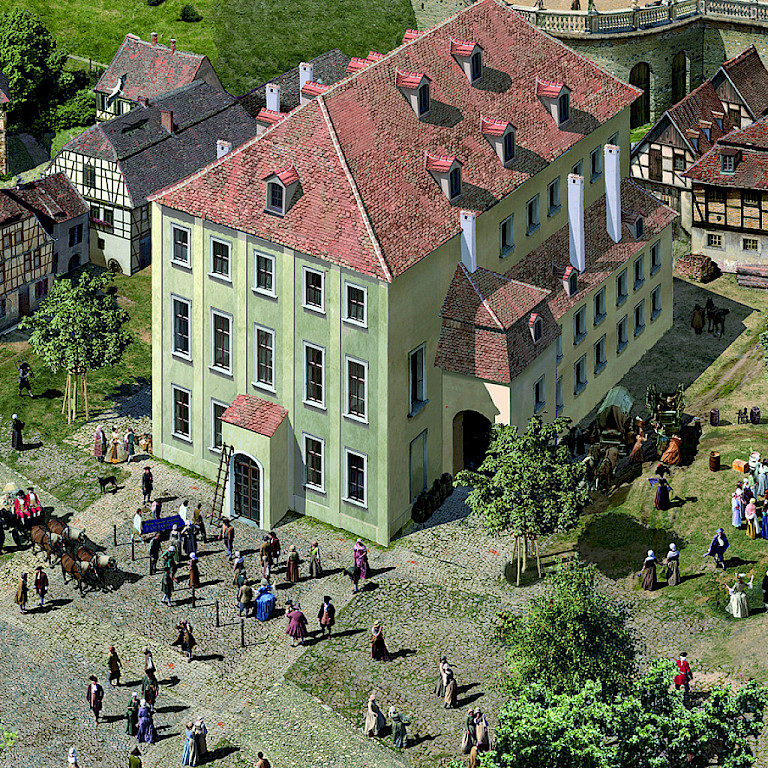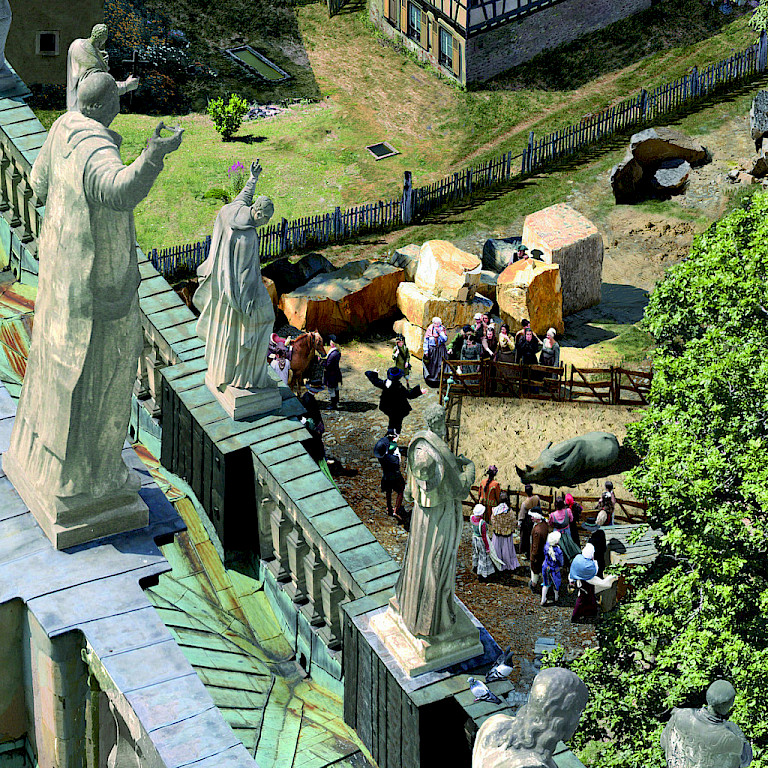
Die Augustusbrücke
Foto: Asisi Panometer

Die Augustusbrücke mit der königlichen Kutsche
Foto: Asisi Panometer

Räuberbande im Schinderkarren auf der Augustusbrücke
Foto: Asisi Panometer

Das Brühlsche Palais (Gartenseite)
Foto: Asisi Panometer

Teil der Festung
Foto: Asisi Panometer

Blick auf die Brühlsche Terrasse
Foto: Asisi Panometer

Zar Peter der Große mit Gräfin Cosel und Gefolge auf der Brühlschen Terrasse
Foto: Asisi Panometer

Aktrobat vor Publikum unterhalb der Brühlschen Terrasse
Foto: Asisi Panometer

Johann Friedrich Böttger (Mitte) mit Porzellangefäß auf dem Weg zu August dem Starken
Foto: Asisi Panometer

Das Theater des Hofkomödianten Moretti
Foto: Asisi Panometer

Ein Bänkelsänger trägt Neuigkeiten und Geschichten vor
Foto: Asisi Panometer

Das Rhinozeros Clara
Foto: Asisi Panometer
10 FAMOUS PERSONALITIES IN THE PANORAMA
The first version of Yadegar Asisi’s panorama picture of Dresden during the baroque era showed the city on a day in August 1756, shortly before the start of the Seven Year War. In the redesigned version that is shown here, a concrete time is no longer shown. The whole epoch of the Saxon-Polish Union has been put into an atmospheric panoramic work of art. Therefore, there are people from different events and times who are united here in the 360-degree picture. Before some of them are introduced to you, we will make a short remark about the perspective of the panorama picture.
Every panorama needs to have an ideal viewpoint for the observer. As Asisi noticed during his research for the panorama DRESDEN 1756, the best panoramic view of Dresden, the Elbe valley and the surrounding landscape is from the tower of the Catholic Court Church. This was his viewpoint for the redesign of the panorama. This meant that the Catholic Court Church in all its splendour and beauty, could not be in the panoramic view of Dresden. The view goes over the roof of the church and the surrounding city. The Church tower’s shadow can be seen on the left next to the Augustus Bridge.
Under August the Strong, the Elbe bridge was extensively renovated and turned into a magnificent boulevard with separate paths for pedestrians and traffic. The Augustus bridge is a busy place in the panorama: its namesake is crossing it with guardsmen, pages and a six-span gilded carriage. Meanwhile, the flayer's cart brings the notorious head of the band of robbers, Lips Tullian and his accomplices to the Black Gate in the New Town, where the execution site was located at the time. In the opposite direction, the royal jester Josef Fröhlich travels in a curious vehicle. His house, called the Narrenhäusel, which was destroyed in 1945, was located on the right bank of the Elbe at the northern bridgehead.
On the left side of the river Elbe there is the Dresden residence of Heinrich von Brühl, Count of Dresden and Prime Minister of Saxony and Poland. Johann Christoph Knöffel had Brühl create an extensive park with various buildings, pavilions and galleries on the former rampart. The so-called Brühl's splendours were only accessible via a bridge from Brühl Palace. Only high-ranking visitors were allowed to enter the park. In Yadegahr Asisi’s Panorama, Tsar Peter the Great and the famous Countess Cosel, for a few years the favoured mistress of Augustus the Strong, watch the hustle and bustle on the banks of the Elbe from Brühl's Terrace.
The free place between the palace Fürstenberg, the Georgenbau building of the palace and the Catholic Court Church still didn`t have a name in the 18th century. There is also no staircase for public access to the Brühl Terrace. Where in 1814 the stairs will be built one can see the acrobat Johann Karl von Eckenberg demonstrating his feats of strength to an amazed audience. Very close to the Fürstenbergs' house, a group of three crosses the square in the direction of the Royal Palace. In the middle is Johann Friedrich Böttger, who wants to bring the first successfully fired vessel made of reddish porcelain to the Elector.
Looking to the west, where dark storm clouds gather in the sky, you will discover the Zwinger with the opera house, the simple half-timbered houses of the "Italian Village" and the theatre of the court comedian Pietro Moretti. In addition to the Moretti theatres, a banqueting or newspaper singer presents news and spectacular stories to the public. Somewhat hidden in the picture Yadegar Asisi also shows an animal celebrity - the Rhinocerous Clara. The tame Indian rhinoceros was exhibited in Dresden on its European tour in 1747. King Augustus the Third had this exotic animal shown to himself and his numerous children.